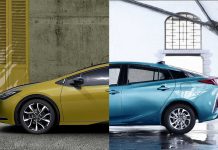“Buy American” … It has a nice, nationalistic, flag-wavin’ sound to it. But the problem is, there isn’t much to buy anymore (car-wise or otherwise) that’s truly American.
Chrysler , for instance, is now controlled by Italian automaker Fiat. And before that, Chrysler was a subsidiary of another foreign industrial conglomerate, Germany’s Daimler AG. Recent Chrysler-badged cars like the popular 300-series sedan and the not-quite-so-popular Crossfire coupe were basically custom-bodied knock-offs of Mercedes-Benz designed vehicles (the E-Class sedan and SLK roadster), fitted with Chrysler-built engines. Even though Chrysler and Daimler have been divorced for quite some time now, the just-launched 2011 “Jeep” Grand Cherokee and the “Dodge” Durango still have Benz M-Class DNA in their sheetmetal. For many years (pre-Daimler) several Chrysler vehicles used Mitsubishi-built engines – or were, in fact, Mitsubishis in toto, albeit with slightly different exterior styling and a “Dodge” badge glued to the fender. (Remember the ’90s-era “Dodge” Stealth? It was a rebadged Mitsubishi 3000GT).
Not to pick on Chrysler.
GM and Ford are guilty, too – if guilt is the right term for what is today an extremely common practice. From out-of-the-closet “partnerships” with the Japanese competition (remember Geo?) to relationships less obvious – but nonetheless, still intimate.
The point being, it is not easy to find a new car that is 100 percent American. Built here, with parts made here.
Many of today’s cars (or their major components) are assembled in different countries before being sold under the nameplate of their home country – and this goes for the “imports” as well as the “domestics.” For instance, GM and Ford both have assembly plants in Mexico. Meanwhile, Nissan, Honda and Hyundai have plants in the United States. There are “American” cars that are built entirely in Mexico – and “Japanese” cars that are built entirely in the United States. Next year, Nissan will buy Dodge Ram pick-ups from Chrysler, badge ’em as “Nissans” and sell ’em as “Nissans.”
Which of these is the “foreign” car? Is it the name on the fender?
What is the magical percentage of “domestic” content? Is it 50 percent? 70?
Who gets to decide?
But when you buy an American-brand car, it is said, the profits stay in America. Well, not necessarily. Money is fungible – and profits is profits. Resources can – and do – go overseas, or across the border, to finance (for example) new plants in other countries (such as GM’s new plants in China) and, if you’re going to be straight about it, jobs for foreign workers in those foreign plants that by definition come at the expense of American workers, in the sense that those jobs are not available to American workers. GM could make Buicks here, using American workers – then ship the cars to China. But it’s cheaper (for GM) to build them in China – in part because of lower labor costs – so that’s what GM does. And, memo to the ardent Buy America crowd: The profits from those sales go into the pockets of GM executives and GM shareholders – not “America.”
Contrariwise, if you buy a Nissan built in Tennessee by an American worker you have helped to support an American worker .
Right?
This is the reality of the global free market – and of the multinational conglomerate, which is what all car companies are, no matter their long-ago origins as representatives of the “motor city” – or wherever.
The plain fact is is there’s no such thing anymore as an “American” car company – or, for that matter, a “Japanese” one. Money moves about as easily as dry leaves on a windy October afternoon. Your new car dollar will be divvied up myriad ways – a portion going to pay for your new car’s Brazilian-sourced transmission, its German-made electronics or maybe even its Japanese-built engine. Even if you carefully research and confine your buying expedition to only those cars with an “American” nameplate that are built entirely in U.S. plants, you will almost certainly still be purchasing some degree of foreign content – and thus, at least a portion of the profit earned from the sale will go to support the foreign company’s operations, including those “un-American” across-the-border plants and the purchasing of foreign-built parts and components.
Just a reality check.
Economic nationalism sounds rugged and manly – and maybe it’s a good thing, if it worked both ways. If, in fact, you are supporting the home team by purchasing the home team’s products – and the home team, in turn, supports you by not offshoring and outsourcing and all the rest of it. Which of course, the home team does not do.
Consider that before reflexively purchasing a “Ford” or “GM” car assembled in Mexico vs. a Honda that was assembled in Ohio by Americans.
The bottom line is – or should be: Buy the best car for the money, for you.










My 96 Nissan Maxima was made in Japan, while my 94 Nissan Pickup was made in Tennessee. Both have high miles on them and still run very well. Both were purchased used. For my money, I want to buy from a company who builds quality cars. I do not care who makes them. I buy a car with 100k on the odometer, and drive them another 100k. The Japanese companies seem to last the longest without too much trouble.
I have two older model (compact-sized) Nissan Frontiers and love them. Great trucks. When our ’98 gets to 200,000 I’ll probably start shopping around for a replacement… another older Frontier!
I agree, the Japanese cars age the best. I think most Nissans, Hondas, and Toyotas will go 300k if taken care of.
As with anything there are exceptions to the rule. I will mention I have a ’94 Saturn with over 400k on the clock and an ’82 Chevy with over 250k on the clock. If you take care of something it will last. But if something was put together with haste, no matter what you do it won’t have the lifespan it should. When I make a comment on here I am reflecting my opinion. But I can go right into facts (since we all know that’s your modus operandi). Japanese car manufacturers have tighter quality control standards than American. “Japanese cars regularly top the J.D. Power customer satisfaction ratings”
http://en.wikipedia.org/wiki/Quality_management
The west has adopted these standards from them. Which pretty much means they started it/introduced it to us/we copied them/however you can conceptualize.. They were doing it first!
Dammit.. -this post was geared for Clover, but his barf-in-text got deleted.
My previous reply was about the location of the assembly plant of the Japanese company that made my car and truck. The one that was made in Tennessee was built with American labor, and some American made parts. A friend of mine has a Pontiac Vibe. It is just a mostly Japanese SUV, built mostly by Americans, and the profits were shared by GM and Toyota. A nieghbor only buys Fords and Chevys. But he might not know that the assembly plant for his truck is in Mexico.
Regarding quality, yes, American cars have improved, Fords and Chevys. Chrysler, well, NO.
They say that Hyndai is much better than they used to be. I will check MSN Autos later on to see how they have held up. If the repair records say that they last say 200,000 miles WITH LITTLE WORK and EXPENSE, I will buy their car. I will do the same with American cars I might consider. One advantage of buying older cars is being able to check how they have behaved for other people. I hate being a guinea pig.
Today, it’s much more nuanced than it was say 20 or even 10 years ago – when as a rule the Japanese brand cars were clearly better-built overall.
Today, there’s more overlap – some American-brand cars are as good (or better) than some Japanese brand cars. Some American brands have gotten much, much better (GM, especially), too – while some of the former Japanese “Blue Chips” (Toyota especially) are not as good as they used to be. Circa 1999, for example, the Lexus LS was probably the best-built car on the road. Today, that’s no longer true.
The only brand I’d be reluctant to get involved with is – no offense to fans – Chrysler. I’ve personally seen evidence of cheaping out and any company that is short on cash/struggling may be missing things here and there, going with the cheapest suppliers, etc.
I agree that some Japanese companies have had quality issues. Toyota has had recent, mulitiple issues. For that matter, my son bought an old Toyota Cressida. It shares its engine with the Supra. Toyota did not tighten the head bolts enough when they decided to cheap out on head gaskets. They never backed up the engine failures. I replaced the engine with a used JDM engine, and new head gasket and ARP head bolts. Now it is a good car. Nissan had financial problems in the late 1990s, and quality suffered. More recently, their Altima engine sucks in bits of a nearby cataytic convertor. This means engine failure.
I think what it comes down to is the financial condition of the car company when the car is produced. If the company is in a hurry to expand production (Toyota) or has financial issues, (Nissan sometimes) or Chrysler…. the manufacturer will cut corners, and quality will suffer. GM and Ford seem to be doing better for now, so they can work on qualtity issues, and have. Chrysler, well…. to be determined.
Recent Hyundais (anything built within the last 3-5 years) are great cars; the early stuff, though, was garbage. Here’s a good rule of thumb: If you see a fairly large number of 10-plus-year-old examples of a given car company’s models on the road in service as daily drivers, it’s a good indication the cars were well-designed and well-built. For instance, older Toyota Corollas are commonplace – especially models from the 1990s. These little SOBs just won’t die if treated at all decently. Now, contrast that with the same-era Dodge Neon. Or the Chevy Cavalier. They were produced in huge numbers but you never see them anymore, or rarely see them. Few are in service as daily drivers. Most have long ago been sent to the junkyard. Because they were crap!
Hi John, I understand your reply was about location. My reply upstairs was not intended for you. I created it as a reply to Clover, but his post got deleted for violating terms of service on this site. I’m in agreement with you though.
Deleted for violating common sense and the minimum-mandatory intelligence quotient! Dealing with Clover is like Howard Stern dealing with Sal. There’s only so much you can do… and only so much one can take!
Older Nissans especially were built like tanks. You couldn’t kill one even if you tried.
I’ve mentioned before that I own a couple of older Nissan pick-ups (the compact-sized Frontier built from ’98-2004; I have a ’98 XE 4WD and an ’02 XE 2WD). Great trucks! My ’98 has never let me down and, with about 130,000 miles on it, still has the original clutch. The ’02 still looks brand new. It has about 70k, so it’s just barely broken in. Should be good for another 150,000 miles at least. Out here in rural SW Virginia, you see a lot of these older Frontiers (and also the previous model, which was just called “Nissan pick-up”). Our neighbor’s son has one with more than 250k on it….
The United States built the first TV sets. Who cares who did something first. Today is all that matters. Today there have been a huge amount of Japanese car recalls.
Are Harley Davidson motorcycles still made in America?
Yep! See: http://www.harley-davidson.com/en_US/Content/Pages/Factory_Tours/kansas_city.html